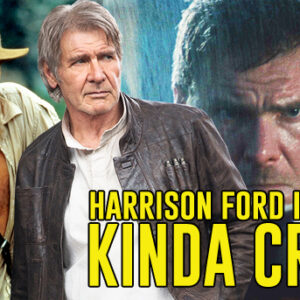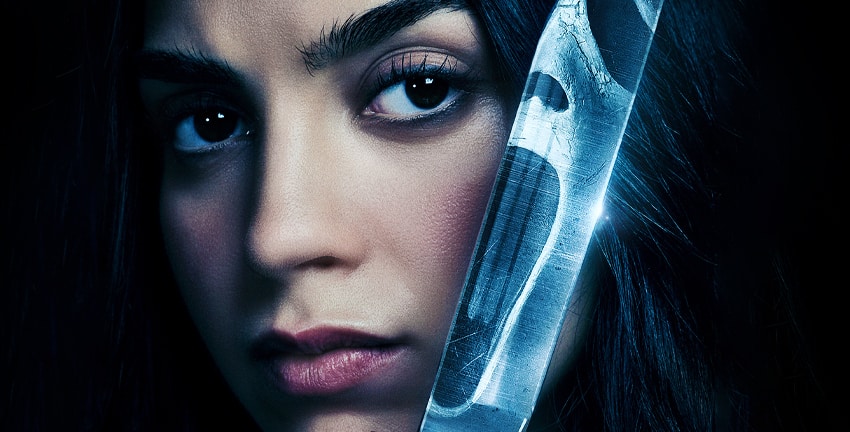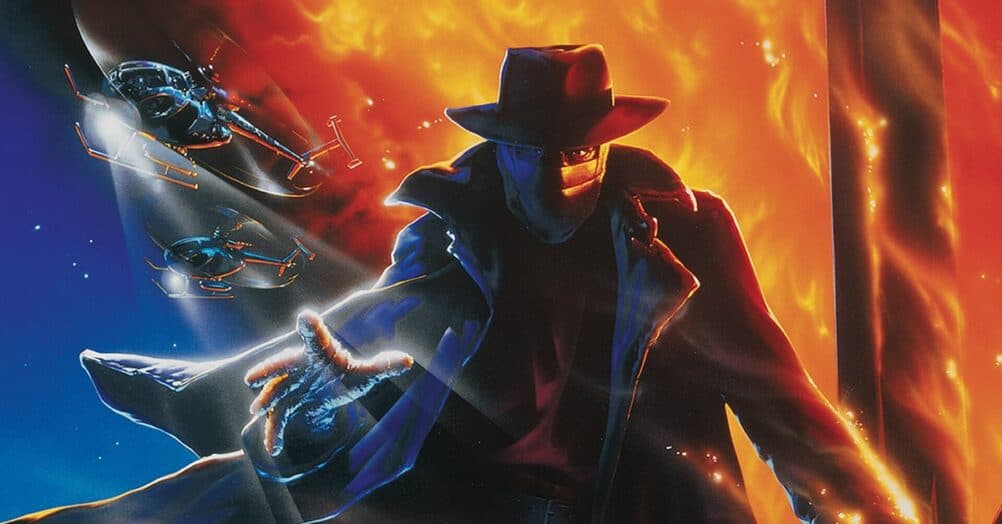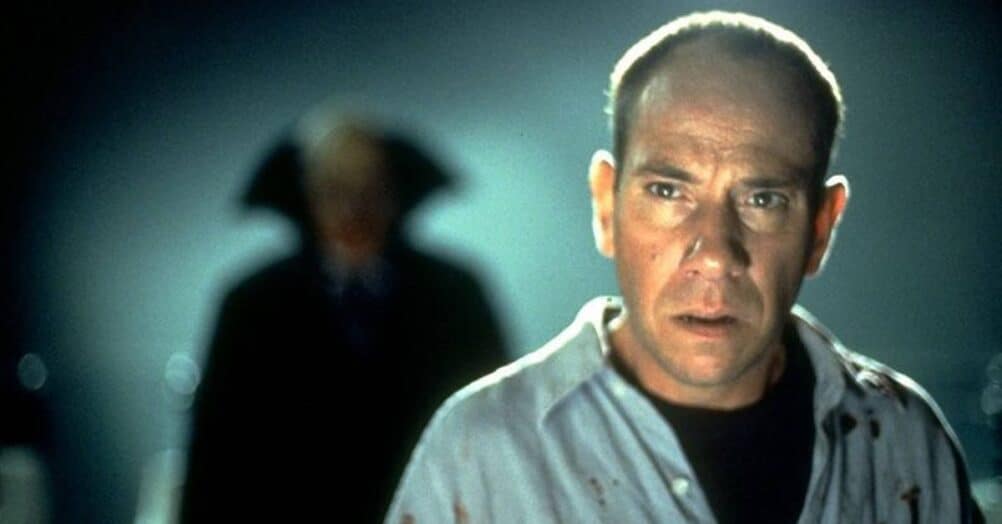Last Updated on August 29, 2024
Welcome to another edition of the Best Horror Movie You Never Saw video series. In this episode, we’re going to be discussing the 1989 high seas thriller Dead Calm (WATCH IT HERE!).
CREATORS / CAST: Directed by Phillip Noyce, produced by Mad Max franchise mastermind George Miller, and scripted by Miller’s The Road Warrior and Mad Max Beyond Thunderdome co-writer Terry Hayes, Dead Calm is based on a 1963 novel by Charles Williams and stars Sam Neill and a very young Nicole Kidman as John and Rae Ingram, a couple who have gone out to sea on their yacht while dealing with the grief of losing their young son in a car accident. After a month at sea, the husband and wife cross paths with a young man named Hughie Warriner, played by Billy Zane, as he flees from a sinking schooner. Hughie tells them that everyone else on the schooner died of food poisoning ten days earlier after eating some bad canned salmon, but John – who served in the Navy and has twenty-five years of experience at sea – has trouble buying his story. Once Hughie falls asleep, John heads over to the schooner and finds that he was right to doubt the stranger, because the other people on board have been murdered and cut to pieces. Unfortunately, this means he has just left his wife on their yacht with a killer. Before John can get back to the yacht, Hughie has taken control of it and taken Rae captive. Stuck on the water-filled schooner, John tries to keep it from sinking so he can use it to catch up with the yacht, while Rae does whatever it takes to make sure she and her husband will both make it through this alive.
Along for the ride is a smart little dog named Ben, but animal lovers should be warned – every fun or clever thing you see Ben do early on is only going to lead to trouble later.
BACKGROUND: Williams’ novel was actually a sequel to his 1960 book Aground, which served as the basis for the 1965 French film The Dictator’s Guns. In that one, John and Rae meet when she hires him to locate a schooner that was stolen by gun runners. The follow-up revisits the characters to tell a story in which John and Rae run into trouble while celebrating their honeymoon at sea – in fact, an early version of the story that was published in an issue of Cosmopolitan was titled Pacific Honeymoon. Thankfully the story had the much better title Dead Calm when it was released as a novel.
This was the second adaptation of Dead Calm to go into production, following a disastrous attempt made by Orson Welles soon after the novel was published. Welles had hoped to turn the story into a thrilling crowd-pleaser, but even after a couple years of off-and-on filming he didn’t manage to get all the footage he needed, and the death of star Laurence Harvey ensured that the project would never be completed. Miller’s production company acquired the film rights from Welles’ estate just months after he passed away in 1985.
Noyce, Miller, and Hayes managed to successfully complete their adaptation, but it wasn’t an easy process. Principal photography took place on the water between the Great Barrier Reef and mainland Australia, with interior scenes being shot on sets that were on top of floatation devices in a large water tank, and filming at sea proved to be so complicated that production stretched on for fourteen weeks.
An indie made on a budget of around six million dollars, Dead Calm secured distribution from Warner Bros. – but the studio did require a new ending to be filmed, almost a year after filming had wrapped, before they would release it. Even with this more exciting climax, the movie only did modest business at the global box office, earning just under eight million in the states. It wasn’t a failure, but it didn’t have much of an impact aside from the fact that Tom Cruise watched it and got Kidman cast in Days of Thunder, starting her career in the Hollywood mainstream. Noyce moved on to Hollywood himself, but was hired to direct films like Blind Fury and Patriot Games based on the merits of things he had done before Dead Calm.
It wasn’t seen by a large audience, but the film was well received by critics. The New York Times has even counted it among the top one thousand movies ever made. It quickly gathered a cult following and remains a cult favorite to this day, even while the creative team seems to have let it fade into the past. It’s rare to see anyone involved talk about the film in depth, and the DVD and Blu-ray releases have been barebones. This really deserves to get a special edition that’s packed with bonus features, but it doesn’t look like one is forthcoming.
WHAT MAKES IT GREAT: Dead Calm is an incredibly well-crafted thriller that establishes a deeply unnerving tone right away, thanks to Hayes’ decision to ditch the honeymoon aspect of the source material and replace it with a tragic back story for John and Rae. The film begins with a sequence that shows exactly how the couple’s son died in the car crash, and Noyce doesn’t pull any punches while doing so, even including a shot in which the toddler’s body is launched through the windshield of Rae’s car. This sequence plays out with very little dialogue, and the dialogue that is there just makes it even more troubling, as John is told that his little boy took twenty minutes to die.
After opening with that gut-punch, we move on to the location where the entire rest of the story will play out; the open sea, with no hint of land in any direction. This setting allowed cinematographer Dean Semler to capture some stunning imagery, but while the vast ocean is nice to look at, when things go wrong this sight also brings a feeling of terrifying hopelessness to the film, driving home the fact that John and Rae will have to make it through this ordeal on their own. They are alone in this. Land is hundreds of miles away, there are no other boats out here, help is not coming.
Noyce and Hayes don’t make us wait long for the thrills; John and Rae have taken Hughie onto their yacht within the first fifteen minutes, and the conflict between them carries on for the rest of the ninety-six minute running time. They did an impressive job of keeping the situation tense that entire time, repeatedly giving John and Rae hope that they’ll be able to get out of this quickly, then throwing more obstacles in their way. It’s a very emotionally and intellectually engaging scenario, making the viewer ponder how they would handle things if they were in Rae or John’s position.
Sam Neill, Nicole Kidman, and Billy Zane are the only cast members for the majority of the film, and each of them did a great job bringing their character to life. Neill’s John comes off as being a very capable person; we root for him to figure out a way to catch up with Rae and Hughie, and even when the odds are stacked against him – and they usually are – it seems like he’s going to be able to pull through this with skill and determination. And yet by the end there has been a reversal; John is the one in serious distress, and Rae has to step up to rescue him.
At first, it may seem like Kidman was miscast. She was only nineteen when filming began and turned twenty during the lengthy production, so she’s truly a bit too young for the character. Rae had originally been envisioned as being thirty-six years old, but Noyce, Hayes, and Miller had been so impressed by Kidman while working with her on a mini-series about the Vietnam War that the character was rewritten specifically for her and changed into a twenty-four year old. For the filmmakers, Rae’s personal journey was the primary focus of the story, and Noyce said, “We felt the audience could identify more with a young woman, because, in a kind of rite-of-passage, she goes from weakness to power, from girlhood to womanhood, from loss to re-growth.”
Rae goes through so much, the audience probably could have sided with a thirty-six-year-old version of the character just as well, but the casting of Kidman worked out for the film and especially for the actress herself.
Rae’s youth also brings an interesting edge to her interactions with Hughie, who is closer to her age than her husband is – Billy Zane is only one year older than Kidman. Hughie is clearly attracted to Rae, and she uses that to her advantage, leading to an uncomfortable sex scene. Zane had appeared in Back to the Future and Critters before this, but Hughie was his most prominent role yet, and what’s really great about his performance is that he didn’t choose to play the character as a completely unhinged lunatic. Hughie tries to be friends with Rae, tries to show her his side of things. The filmmakers dropped Zane off on an island to spend a few days with the actors who appear as the other schooner passengers in home video footage, and during that time he was able to craft his own story for Hughie in which he feels like he was the wronged one. The other passengers turned against him, he had to kill them, and now he’s trying to sail away to freedom. Hughie is the hero in his own story… but he does some very bad things that we can’t condone. So when we reach the re-shot ending in which Hughie is definitively taken out in a very flashy way, we don’t feel too bad for him.
Much like the ending of Fatal Attraction, this ending was added when test screening audiences reacted poorly to the more low-key, ambiguous ending the filmmakers originally wanted the film to have. It’s a little obvious that it was tacked on, but it works.
BEST SCENE: One of the greatest scenes in the film comes when John realizes what Hughie has done on the sinking ship, and that leaving Rae on the yacht with him was a bad idea. He jumps in a dinghy and tries to cover the distance between the two ships before Hughie can take the yacht away. Watching a guy try to row a dinghy quickly may not sound like something that would be exciting, but the performances of the actors, the editing by Richard Francis-Bruce, and the music by Graeme Revell all work together to make this a standout sequence that effectively gets the pulse pounding.
It generates genuine tension, and ends with John trying to jump from the dinghy to the yacht, but he doesn’t quite make it and falls into the water. In an interview conducted in 1989, Noyce pointed to that shot of Neill in the water as an example of how tough filming this movie could be. “There’s two divers underneath the water, one’s holding on to his left foot and one’s holding on to his right foot. There’s a dinghy behind him, and that’s anchored in two spots. And the big 150 foot boat is behind the two of them, and that’s being held there by two tugboats, which you can’t see on the film. And, of course, our camera’s on another boat. Just imagine that, trying to get all of those elements to line up.” After hearing that, it’s easy to understand why this thing took fourteen weeks to film.
PARTING SHOT: Just the fact that the filmmakers were able to complete Dead Calm and thus succeeded where the legendary Orson Welles had failed makes this movie a notable curiosity that’s worth seeking out. Once you do, you’re rewarded with a harrowing thriller that features some great acting and has a thick atmosphere of tension and dread hanging over every minute of it. The idea of watching a film that mainly follows just three characters as they sail the ocean may seem daunting to some viewers, but the filmmakers kept things moving at a good pace and never let too many minutes go by without something exciting or awful happening. Because of this, more than thirty years after it came and went at the box office, Dead Calm still holds up.
PAST BEST HORROR MOVIE YOU NEVER SAW EPISODES!


















Follow the JOBLO MOVIE NETWORK
Follow us on YOUTUBE
Follow ARROW IN THE HEAD
Follow AITH on YOUTUBE